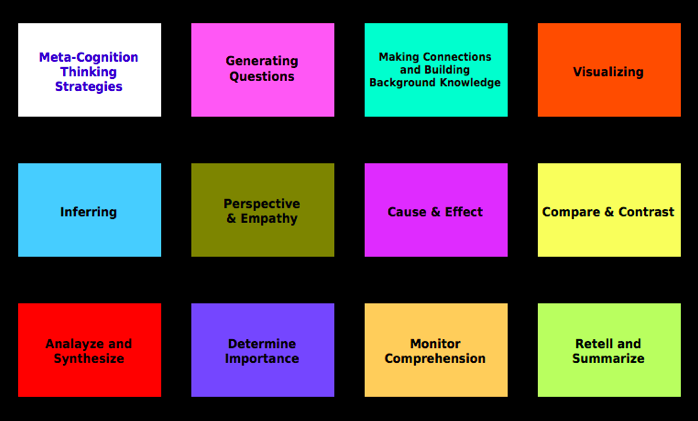Making Critical Thinking Explicit and Intentional
Posted on 3/5/2017

It is natural that we think as we read, but when we are able to name our thinking with a common language and shared understandings, we are empowered to become intentional about developing and exercising our thinking skills as a habit of mind.
There are ten types of cognitive processes that we may refer to as the ABCs of critical reasoning. We use them to understand complex situations, generate solutions to problems, and nurture new insight.
These cognitive processes become even more powerful when we reflect upon how we have used them, aiming to self-evaluate and improve our cognitive processes. We refer to this as meta-cognition (thinking about thinking).
Meta-cognition involves three types of knowledge:
- knowledge of cognitive process
- knowledge of strategies and tasks (applying the cognitive processes)
- knowledge of self
1. Connect Background Knowledge
Make connections to what is being read with prior knowledge and personal experiences.
2. Generate Questions
Ask open-ended questions to propel reading forward. Ask why a character behaves or feels a certain way. Ask what are the implications of specific events or choices.
3. Visualize
Form mental sensory and emotional images to make meaning and deepen understanding. Read, think, and create movies in the mind.
4. Infer
Think about what is implied. Read between the lines and put two and two together. Make predictions and come to conclusions supported by evidence.
5. Gain Perspective and Empathy
See through the eyes of the character (perspective) and feel the character’s emotions (empathy). Walk in the shoes of the character.
6. Compare and Contrast
Identify and think about similarities and differences between people, places, objects, and events – within the text and between the text and the real world.
7. Identify Cause and Effect
Determine why an event happened and the impact it has on a character or situation. Think, “because this happened, that happened.”
8. Analyze and Synthesize
Understand by taking apart the constitution or structure of a person, place, object, or event (analyze). Understand by putting knowledge and ideas together to solve problems and create solutions (synthesize).
9. Determine Importance
Decide what ideas and details matter most to make meaning, to make decisions, and to solve problems.
10. Monitor Comprehension
Recognize when understanding breaks down. Ask questions and reread to make meaning and clarify understanding.
Whether you are a teacher or parent, model thinking aloud these critical thinking skills as often as possible and they will soon become a habit of mind for you and your learners!
Be a thinking reader.
Be a lifelong learner.
Learn more about Brian's work at LearnOnPoint.com